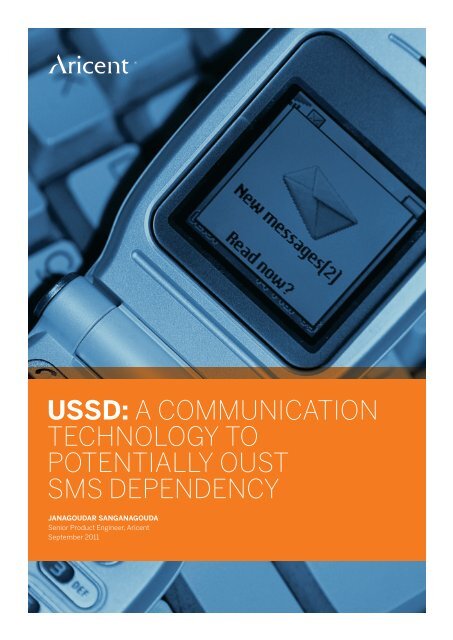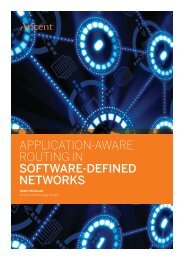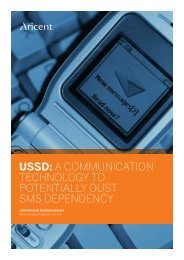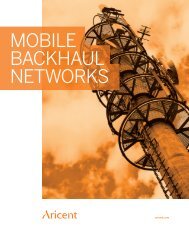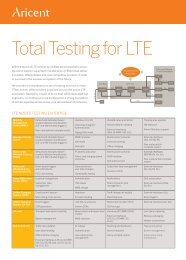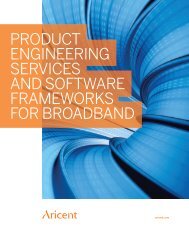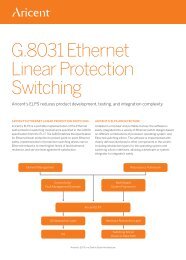ussd: a communication technology to potentially oust sms ... - Aricent
ussd: a communication technology to potentially oust sms ... - Aricent
ussd: a communication technology to potentially oust sms ... - Aricent
- No tags were found...
You also want an ePaper? Increase the reach of your titles
YUMPU automatically turns print PDFs into web optimized ePapers that Google loves.
USSD: A COMMUNICATIONTECHNOLOGY TOPOTENTIALLY OUSTSMS DEPENDENCYJANAGOUDAR SANGANAGOUDASenior Product Engineer, <strong>Aricent</strong>September 2011
DISCLAIMERSThis white paper provides an overview of Unstructured SupplementaryService Data (USSD) <strong>technology</strong> as compared <strong>to</strong> Short Message Service(SMS). It presents information and guidance but does not support aspecific plan of action, which would require additional information andinsights in<strong>to</strong> each situation. The vulnerabilities, analyses, and risks shownand analyzed in this paper are intended <strong>to</strong> be indicative of the risks anapplication vendor, third-party host, or network opera<strong>to</strong>r might face.The analysis given should not <strong>to</strong> be considered an exhaustive or fullyobjective list.It is important that risks be assessed and validated based on the situation,the intended functionality <strong>to</strong> be offered, and the process controls thatwill be required or are already in place. Additional guidance should besought wherever necessary before taking any action.ABSTRACTValue Added Services (VAS) have become an indispensable part of theproducts and services offered by mobile/telecom opera<strong>to</strong>rs <strong>to</strong>day. Withgrowing competition in the telecom industry, opera<strong>to</strong>rs must be diligentin how they price both new and existing services. They are thereforelooking for faster and more economical technologies.USSD <strong>technology</strong> is the key solution in all cases. It is a messaging servicethat is almost seven times faster than SMS and is highly cost effective.The operations involved in using USSD are simple and handset independent,which means the service can be accessed from almost any mobile device(from old cell phones <strong>to</strong> the latest smartphones).From the core network <strong>to</strong> the internet, the reach of modern USSD servicesis rapidly transforming the telecom cloud in<strong>to</strong> a services cloud. USSDis fast emerging as the <strong>communication</strong> pro<strong>to</strong>col, which can <strong>oust</strong>er thedependency on SMS for quick messaging services like spreadingawareness about epidemics and fatal diseases <strong>to</strong> the users, mobilebanking using USSD, updating mobile software over-the-air (OTA), andmany others.SCOPE AND ASSUMPTIONSThis paper discusses the key features of USSD <strong>technology</strong>. It alsoemphasizes on three business messaging applications in detail withrespect <strong>to</strong> their economic viability, profitability, scalability and ease ofimplementation using USSD in comparison <strong>to</strong> using SMS <strong>technology</strong>.However, it does not cover:1 Implementation details of any specific application2 Generalized rules based on which USSD codes are derived (USSDcodes are derived using a set of rules and are affixed <strong>to</strong> identify aspecific service. Users must enter the defined code <strong>to</strong> access theservice, but do not need <strong>to</strong> bother about its derivation.)3 Detailed description of the Multi Media Interface (MMI) commandsused in USSDThis technical paper assumes the reader has a fair knowledge of theGSM network.
The MSC connects <strong>to</strong> the HLR in the home network via theSS7 network. GSM network (including HLR, VLR, MSC) is alsoconnected <strong>to</strong> the USSD Gateway via the SS7 link. The USSDGateway communicates with all its supporting externalapplications via SMPP.Generally, billing is based on the duration of the session. Durationbasedcharging permits users <strong>to</strong> search for information within asession-based service. It is charged on a per minute basis and ismore economical than SMS. USSD is device independent anddoes not require specific activation.3.1 ELEMENTS OF USSD MOBILE NETWORKThe mobile network comprises components that carry datamessages between the handset and the corresponding USSDapplication. Figure 2 explains the elements of the mobilenetwork and the <strong>communication</strong> pro<strong>to</strong>cols they use.USSD services reside as applications in the mobile network.These applications can reside in MSC, VLR, HLR, or anindependent application server that is connected through aUSSD Gateway (using SMPP).If a USSD message is not destined for an application in the MSC,VLR, or HLR, a USSD handler in these nodes routes the message<strong>to</strong> the USSD Gateway using the MAP pro<strong>to</strong>col based on theservice code. The gateway interprets the code and routes it <strong>to</strong>the specific USSD application server <strong>to</strong> fetch the necessaryinformation requested by the user. In response, the applicationsends the relevant information <strong>to</strong> the USSD Gateway, which inturn converts the message <strong>to</strong> MAP format, and then sends <strong>to</strong>the mobile terminal.Applications under the mobile opera<strong>to</strong>r’s control will typicallyreside in the GSM network (MSC, VLR, HLR), while third-partyapplications may reside elsewhere such as on the internet.The application can also be a hyperlink <strong>to</strong> an internet site orinformation s<strong>to</strong>red locally in the Service Application System.In a mobile-initiated service request, a session is created betweenthe network and the mobile terminal. This session is used forall information transfers and must be released before anothersession can be started. Additionally, an application in thenetwork (residing in the MSC, VLR, HLR, or external applicationserver) may at any time send a message <strong>to</strong> a mobile terminal.This can be a request for information or a notification. Again,the session must be released upon completion.3.2 BILLING OF USSD USAGE SERVICESA billing mechanism for USSD services is not implementedin most cases. However, there are some rare cases wherenetwork opera<strong>to</strong>rs implement a billing system. Depending onthe sophistication of the rating platform, the subscriber will bebilled according <strong>to</strong> one of the following criteria:1 One-off cost2 Number of menu transactions3 Time spent browsing the menu/duration of the session4 USSD HANDLINGThere are two modes of USSD implementation:1 Push Service Mode: Network-initiated USSD service inwhich the network (MSC, VLR, or HLR) sends USSDmessage <strong>to</strong>ward MS2 Pull Service Mode: MS-initiated USSD service with usersending USSD message <strong>to</strong>ward MSC4.1 NETWORK-INITIATED USSD OPERATIONSAt any stage while the MS is registered with a network, thenetwork (HLR, VLR, or MSC) can send a USSD string <strong>to</strong> the MS.This string contains opera<strong>to</strong>r-determined information that isrelevant <strong>to</strong> the user.This string/USSD command may be a request (asking the MS <strong>to</strong>provide information) or a notification (requiring no informationfrom the MS). If the information is unable <strong>to</strong> reach the MS, anerror is returned <strong>to</strong> the network node that originated theoperation.4.2 INVOKING USSD OPERATION FROM THE MSC, VLR,AND HLRWhen an application in the MSC needs <strong>to</strong> send a USSD reques<strong>to</strong>r notification <strong>to</strong> an MS, it sets up a transaction <strong>to</strong> the MS wherethe subscriber is currently registered and sends the operation<strong>to</strong> the MS. The MSC then awaits a response from the MS.Because the MSC initiated the transaction, it is also responsiblefor controlling the transaction. The MSC normally releases thetransaction after receiving a response from the MS, but in somecases MSC may release the transaction before receiving a response(e.g., if an application timer expires).If the application in the MSC needs <strong>to</strong> send further operations<strong>to</strong> the same MS, it will continue <strong>to</strong> use the same transactionuntil all operations are completed. If a different transaction isused for a subsequent operation, the MSC releases the firsttransaction before starting the next. If the MS releases thetransaction at any time (e.g., due <strong>to</strong> the user clearing), MSCinforms its application and terminates the USSD operation.(An MSC-invoked USSD request is likely <strong>to</strong> be used for callrelatedoperations where the application is controlling a call <strong>to</strong>or from the MS.)USSD: A Communication Technology <strong>to</strong> Potentially Ouster SMS Dependency5
MS MSC VLR HLRUSSDUSSDUSSDFigure 4 shows the message flow for USSD requests failed atVLR, MSC, MS for a single operation.HLRVLRUSSDReleaseUSSDUSSDReleaseUSSDReleaseUSSDUSSDReleaseUSSDReleaseActions at MSThe MS may at any time receive a USSD operation request/notification from MSC. The MS processes the operation if it is ina state in which it can handle the operation. After sending theresponse <strong>to</strong> a USSD operation, the MS waits for the network <strong>to</strong>release the transaction. While awaiting this release, the MS willprocess any further USSD operation requests in the normal way.MSC initiatedUSSDUSSDAt times, MS may not be able <strong>to</strong> process the network-initiatedUSSD because of the following reasons:Release1 Feature not supported by the user (MS)Figure 3: Information flow for a USSD request (single operation)Figure 3 shows the message flow for a network-initiated (HLR,VLR, and MSC) USSD request for a single operation.In another case, when an application in the VLR needs <strong>to</strong> senda USSD request or notification <strong>to</strong> an MS, it sets up a transaction<strong>to</strong> the MSC where the subscriber is currently registered andsends the operation <strong>to</strong> the MSC. The MSC further interacts withthe MS as explained above. The VLR then awaits a response fromthe MSC. Because the VLR initiated the transaction, it is alsoresponsible for controlling the transaction.In a third case, when an application in the HLR needs <strong>to</strong> send aUSSD request or notification <strong>to</strong> an MS, it sets up a transaction<strong>to</strong> the VLR where the subscriber is currently registered andsends the operation <strong>to</strong> the VLR. The VLR further interacts withthe MSC which then interacts with the MS as stated above. TheHLR then awaits a response from the VLR. Because the HLRinitiated the transaction, it is also responsible for controlling thetransaction. The HLR normally releases the transaction afterreceiving a response from the VLR.VLR cannotcontactsubscriberMSCcannot contactMS MSC VLR HLRUSSDErrorUSSDUSSDErrorError2 Alphabet indicated in USSD is not supported by MS3 User is engaged in another USSD session (network- ormobile-initiated)4 A non-call related supplementary service transaction is inprogress. In all the above failure cases, an error indica<strong>to</strong>rwill be returned <strong>to</strong> the origina<strong>to</strong>r (MSC or VLR or HLR)4.3 MOBILE-INITIATED USSD OPERATIONSThe MS may initiate a USSD operation either during a call oroutside.Actions at the NetworkIf the serving network (MSC) does not recognize the USSD codein a mobile-initiated USSD operation, it sends the operation <strong>to</strong>the next level (i.e., VLR). If VLR also does not recognize/decodethe operation, it forwards the same request <strong>to</strong> HLR. If even HLRis unable <strong>to</strong> decode it, an error message gets passed downwardand the session is terminated.If MSC, VLR, or HLR (in the same hierarchical order) is able <strong>to</strong>decode the operation/service requested, and if either of thenetwork nodes has the required data, then this information getspassed downward back <strong>to</strong> MS. However, if the network nodesare able <strong>to</strong> decode the operation/service request, but can’tsupport the required application, then a check is made with theUSSD platform. The decoded request is forwarded <strong>to</strong> USSDGateway and then <strong>to</strong> USSD applications <strong>to</strong> fetch the requiredinformation.If the mobile-initiated USSD transaction is found <strong>to</strong> beErrordetected at MSMS clearstransactionsUSSDErrorUSSDUSSDErrorUSSDUSSDErrorUSSDincompatible, the operation is rejected by a non-supportingnetwork and the attempt fails. Figure 5 shows the flow diagramfor a mobile-initiated USSD request. (The application at MSC/VLR may pass the request <strong>to</strong> another network element. Thatscenario is not shown here.)ReleaseReleaseReleaseFigure 4: Information flow for a failed USSD requestUSSD: A Communication Technology <strong>to</strong> Potentially Ouster SMS Dependency6
Requesthandled byMSCRequesthandled byVLRRequesthandled byHLRMS MSC VLR HLRUSSD requestUSSD responseUSSD requestUSSD responseUSSD requestUSSD responseFigure 6 shows the message flow for a mobile-initiated USSDrequest that failed at MSC, VLR, and HLR. It also depicts a casewhere an MS clears the transaction before it receives a response<strong>to</strong> the initiated USSD request.USSD requestUSSD responseUSSD requestUSSD responseUSSD requestUSSD responseFigure 5: Information flow for a mobile-initiated USSD requestUSSD is an excellent choice for roaming with mobile prepaidservice, which utilizes the USSD connection <strong>to</strong> originate a callwhile roaming. USSD messages from handsets always route <strong>to</strong>the home network. Thus, when roaming in another network,dialing a USSD string will always route the application on thehome network. This feature allows for the virtual homeenvironment concept.The MSC connects <strong>to</strong> HLR of the home network via VLR usingthe SS7 network. The HLR sends the request <strong>to</strong> the USSDGateway, which in turn passes the request <strong>to</strong> the prepaidapplication server. The application server ascertains the user’sbalance and provides instructions for handling the call via thesame path <strong>to</strong> the serving MSC in the visited network.Also, users accus<strong>to</strong>med <strong>to</strong> accessing a particular service in theirhome network are able <strong>to</strong> access that network from anothercountry. The processing happens in the same way as explainedabove, but the supporting USSD application server may bedifferent. Conversely, roaming subscribers from other networkscannot access USSD services on a host network.6 STRATEGICAL BUSINESS APLICATIONSUSING USSDErrordetected atMSCMS MSC VLR HLRUSSD requestErrorServices requiring menu-/session-based interaction betweenthe user and the application are ideal for offer via USSD. Somestrategic applications that can be developed or are still in theirnaive stages of development are discussed below in detail.Errordetected atVLRErrordetected atHLRMS clearstransactionbeforeresponsereceivedUSSD requestErrorUSSD requestErrorUSSD responseReleaseUSSD requestErrorUSSD requestErrorUSSD responseReleaseUSSD requestErrorUSSD responseReleaseFigure 6: Information flow for a failed mobile-initiated USSD request6.1 MOBILE BANKING VIA USSDNo other channels have the ability <strong>to</strong> reach the consumer asthoroughly as mobile phone. The coverage of cell phone networksin relation <strong>to</strong> fixed ATMs and branches helps reach morecus<strong>to</strong>mers.Architectural view of banking systemA bank’s core banking system houses consumers’ accounts,related transaction management, and his<strong>to</strong>ry. It is necessaryfor translating banking instructions received from consumersthrough bank channels such as ATMs, the internet, and mobiledevices in<strong>to</strong> a format it can process.5 USSD USAGE AT HOME AND ROAM NETWORKUSSD can be accessed via two locations: Home Public Land MobileNetwork (HPLMN) and Visited Public Land Mobile Network (VPLMN).USSD messages can be handled either from the VLR or the HLR,depending on the current location of the user. When accessingUSSD at the home location (HPLMN), the user directly communicateswith the HLR in case of a mobile-initiated USSD operation. And whenaccessing USSD at a visi<strong>to</strong>r location (VPLMN), the user communicates<strong>to</strong> the HLR through the VLR.ATMCore Banking SystemEFT Channel SwitchMobile servicesBranchClient side Server sideJ2ME SMS USSD IVRFigure 7: The Banking System ArchitectureWebUSSD: A Communication Technology <strong>to</strong> Potentially Ouster SMS Dependency7
This translation is normally performed by an Exchange TradedFunds (EFT) channel switch that switches transactions from thechannel <strong>to</strong> the appropriate area within the core banking system.Client-side applications refer <strong>to</strong> those applications that resideon the cus<strong>to</strong>mer’s SIM card or mobile phone device. Client-sidetechnologies include J2ME. On the other hand, server-sideapplications are developed on a server away from cus<strong>to</strong>mers’mobile phone or SIM card. Server-side technologies includeUSSD, IVR, SMS, and WAP.6.1.1 CRITICAL REVIEW OF SECURITY OPTIONS FORMOBILE BANKINGMobile banking brings new opportunities and new horizons, butalso comes with implicit risks <strong>to</strong> financial providers, carriers, andthe financial system. On the one hand, it holds out the prospec<strong>to</strong>f adding convenience for accessing banking and paymentservices <strong>to</strong> cus<strong>to</strong>mers. But the addition of a new channelalso brings new operational risks <strong>to</strong> providers, just as theintroduction of internet banking posed the risks a decade ago.For this reason, mobile Financial Service Providers (mFSP)seeking <strong>to</strong> enter the market have <strong>to</strong> assess their risks and developstrategies <strong>to</strong> mitigate those risks on an ongoing basis. Securityis a very sensitive issue for M-Banking, so this section comparesthe risks of using SMS and USSD messaging services.Data carried across the mobile network is protected by thestandard GSM security pro<strong>to</strong>cols at the <strong>communication</strong> layer.The subscriber identity is also protected across this chain. Therisk in transporting data across the GSM channel is directlydependent on the number of s<strong>to</strong>ppages the data must makebefore reaching the bank.Data security with SMS bankingSMS service is deemed <strong>to</strong> be the least secured of the technologiessuggested for mobile banking because of the number of pointswhere the SMS data is available <strong>to</strong> others in a clear or unencryptedformat.The diagram below shows the entities involved across the GSMchannel in SMS banking.Base stationMSC SMSC BankFigure 8: SMS Banking GSM ChannelA cus<strong>to</strong>mer initiates a transaction by sending an SMS <strong>to</strong> the bankusing the bank’s SMS short code. The SMS is s<strong>to</strong>red on thehandset and is available <strong>to</strong> anyone who looks at the cus<strong>to</strong>mer’sphone; hence, making it unsecure at the very first step. The SMSthen passes through the encrypted GSM <strong>communication</strong>channel through the base stations and terminates at the mobilenetwork opera<strong>to</strong>r’s SMSC. There, it is typically s<strong>to</strong>red in anunencrypted form, making it unsecure at also the second step.The SMSC passes the message on<strong>to</strong> the bank’s wirelessapplication processor or mobile banking processor (which maybe a third party), where it is s<strong>to</strong>red either in encrypted orunencrypted form. The third party then passes the message <strong>to</strong>the bank across an encrypted fixed line <strong>to</strong> the bank, where it istypically s<strong>to</strong>red in a secured environment.In all, there are three highly susceptive points of exposure duringthe transaction where the data is s<strong>to</strong>red, making the SMS servicefar less secure.Data security with USSD bankingUnlike SMS, USSD message is not s<strong>to</strong>red on cus<strong>to</strong>mers’ mobile,making it secure at the first level. USSD opens a single sessionbetween the device and the supporting application at thenetwork opera<strong>to</strong>r/processor/bank.Base stationMSC USSD Gateway BankFigure 9: USSD Banking GSM ChannelThe data is also encrypted at the USSD gateway sitting at thenetwork opera<strong>to</strong>r/processor/bank, preventing any misuse ofthe data. This makes it secure at the second step. The end-<strong>to</strong>-endtransaction flow occurs across the encrypted GSM<strong>communication</strong> layer while the subscriber identity is also hidden.Hence, USSD service is safer than <strong>to</strong> SMS and other GSMtechnologies.However, there is one risk. If the GSM encryption (which is used<strong>to</strong> carry the data within the <strong>communication</strong> layer by securedmeans) is broken, the data can be accessed–which can actuallyhappen with all GSM technologies (e.g., SMS, USSD, etc.). Toavoid this, the GSM encryption needs <strong>to</strong> be made more robust,much like how internet banking has evolved over the years.Excluding this generic threat, USSD appears <strong>to</strong> be the mostsuited <strong>technology</strong> for mobile banking application.USSD: A Communication Technology <strong>to</strong> Potentially Ouster SMS Dependency8
6.1.2 MARKET PROJECTIONS FOR M-BANKING USERSA recent report from Juniper Research gives a detailed forecastfor mobile banking users by 2011 across eight regions of theworld (Figure 10).Scalability and costs involved in using SMSThe size limit of 160 characters restricts the amount of contentinformation that can be communicated through text. A detaileddescription of any disease/medicine therefore requires two ormore messages, which means extra costs for an opera<strong>to</strong>r.7%5%8% 12%2%22%North AmericaSouth AmericaWestern EuropeEastern EuropeSMS delivery charges are costlier because they involve SMSCand other related transmission trunks. Also, scheduling costsof SMS are much higher because traffic at network and itsavailability versus traffic at SMSC must be taken in<strong>to</strong> account.41%6.2 SPREADING AWARENESS ABOUT EPIDEMICSAND FATAL DISEASESUSSD service can be used innovatively <strong>to</strong> educate people andspread awareness about fatal, epidemic diseases such as AIDS.For many of these diseases, prevention still remains the onlyavailable cure. Taking early disease-prevention measures,educating people about their symp<strong>to</strong>ms, providing anonymouscounseling, gathering data, linking patients <strong>to</strong> services, andmany other such acts can go a long way in improving thehealth of developing nations.For millions of people affected by HIV and other diseases, thereis an unmet need <strong>to</strong> circulate information regarding these diseases.Currently, this information is disseminated in numerous waysincluding print media, radio, television, newspapers, and theinternet. However, not all of these channels are accessible<strong>to</strong> everyone; hence, using cell phones <strong>to</strong> reach the massesseems an obvious extension.The information people require varies from basic knowledgelike symp<strong>to</strong>ms or prevention measures <strong>to</strong> a more detailedunderstanding of a particular disease’s course and treatment.The menu implementation of USSD can be set in a singletransaction, and the interested users can dig in<strong>to</strong> the requiredinformation.3%Far East & ChinaIndian SubcontinentRest of Asia PacificAfrica & Middle EastFigure 10: Mobile Banking Users – 2011 Regional Forecast (%)Reference: Juniper Research6.2.1 SMS VERSUS USSD FOR IMPLEMENTING THE SERVICEStudies have indicated that reminding people <strong>to</strong> take theirmedicine on time can increase adherence <strong>to</strong> treatment. Thesemessages need <strong>to</strong> be timed appropriately <strong>to</strong> suit each purpose.When patients regularly skip taking their medicine, or take it atthe wrong time, the severity of their disease can increase, oftennecessitating costlier and more expensive second-line treatment.Scalability and costs involved in using USSDUSSD’s 180-character capacity per message increases thescope for content length. And because the USSD platformsends messages directly without using SMSC, it is lessexpensive than SMS.In-depth information can be provided via a menu-basedapproach using which the interested users can drill down <strong>to</strong> thedidactic content. Hence, an opera<strong>to</strong>r can provide handy tips ina common, free message while the cost of providing additionalinformation can be charged <strong>to</strong> the user (only if the user uses aninteractive USSD menu-based session). The messages can alsobe better timed by using USSD rather than SMS because thereis no need <strong>to</strong> account for network congestion at SMSC.Impact or AnalysisIt can be concluded from this discussion that the USSD<strong>technology</strong> can go a long way in improving the living conditionsof the poor.Assuming that this innovative service is offered at no extra cost<strong>to</strong> cus<strong>to</strong>mers (at least in developing and underdevelopedcountries), the analysis is done only with respect <strong>to</strong> the operatingcosts for opera<strong>to</strong>rs/service providers.Although USSD is an efficient <strong>technology</strong>, it’s <strong>to</strong>o early <strong>to</strong> deriveany conclusion on the impact and effectiveness of this servicebecause data collection from the end user is an arduous job.Many people don’t want <strong>to</strong> share information about their diseases,or register with the opera<strong>to</strong>r for fear it may lead <strong>to</strong> disclosure oftheir personal data.This medical care application was just an example <strong>to</strong> demonstratehow USSD can be used in broadcasting relevant messages <strong>to</strong>the cus<strong>to</strong>mers, especially in the health sec<strong>to</strong>r. There are manyother similar areas where this service can prove beneficial suchas in alerting fishermen about the rising tides and sea/weatherconditions; teaching farmers about the best seasonal crops <strong>to</strong>grow in different regions and the new innovative <strong>to</strong>ols available<strong>to</strong> improve agricultural productivity; and informing students onjob trends and career opportunities.USSD: A Communication Technology <strong>to</strong> Potentially Ouster SMS Dependency9
INNOVATIONSERVICESFOR THECONNECTEDWORLDThe <strong>Aricent</strong> Group is a global innovation and <strong>technology</strong> servicescompany that helps clients imagine, commercialize, and evolveproducts and services for the connected world. Bringing <strong>to</strong>gether the<strong>communication</strong>s <strong>technology</strong> expertise of <strong>Aricent</strong> with the creativevision and user experience prowess of frog, the <strong>Aricent</strong> Groupprovides a unique portfolio of innovation capabilities that seamlesslycombines consumer insights, strategy, design, software engineering,and systems integration. The client base includes <strong>communication</strong>sservice providers, equipment manufacturers, independent softwarevendors, device makers, and many other Fortune 500 brands. Thecompany’s inves<strong>to</strong>rs are Kohlberg Kravis Roberts & Co., SequoiaCapital, The Family Office, Delta Partners, and The Canadian PensionPlan Investment Board.
aricent.com © 2012 <strong>Aricent</strong> Group. All rights reserved.All <strong>Aricent</strong> brand and product names are service marks, trademarks, orregistered marks of <strong>Aricent</strong> Inc. in the United States and other countries.


